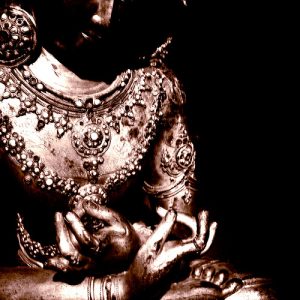White Tara Meditation

White Tara Meditation
White Tara is a female Bodhisattva typically associated with Tibetan Buddhism. She is one of the more popular figures in the Tibetan pantheon of deities. Tara (pronounced tah' rah), whose name in means “Star,” originated in Indian Hinduism as the Mother Creator, and her many representations spread from Ireland to Indonesia under many different names. As White Tara, she rose from a lotus blooming in the lake that formed from the first tear of compassion of great Bodhisattva Avalokitesvara (whose human incarnation is the Dalai Lama) and is considered his consort
Tara is a female Bodhisattva typically associated with Tibetan Buddhism. She is one of the more popular figures in the Tibetan pantheon of deities.
Tara (pronounced tah' rah), whose name in means “Star,” originated in Indian Hinduism as the Mother Creator, and her many representations spread from Ireland to Indonesia under many different names. As White Tara, she rose from a lotus blooming in the lake that formed from the first tear of compassion of great Bodhisattva Avalokitesvara (whose human incarnation is the Dalai Lama) and is considered his consort
The White Tara is the personification of compassion, long life, healing, and serenity. The followers of the White Tara believe that the gift of longevity is granted for the practice of compassion and service to others.
The basic words for the Tara Mantra are:
Om Tare Tuttare Ture Svaha
(pronounced: Ohm, Tahray, Tootahray, Tooray, Swahhah)
The specific words for the White Tara Mantra are:
Om Tare Tuttare Ture Mama Ayus Punya Jñana Pustim Kuru Svaha
(Pronounced: Ohm, Tahray, Tootahray, Tooray, Mahmah, Ahyoor, Poonyay, Jnana, Pushtim, Kuru, Swahhah)
Free eBook
For a better understanding of the meditation, please read this free document outlining the meaning and message of the White Tara Mantra.
Video Information
Original Chanting by Isabella Rajotte
FAIR USE NOTICE
This video may contain copyrighted material the use of which has not always been specifically authorized by the copyright owner. We are making such material available in our efforts to advance understanding of environmental, political, human rights, economic, democracy, scientific, and social justice issues, etc. We believe this constitutes a 'fair use' of any such copyrighted material as provided for in section 107 of the US Copyright Law. In accordance with Title 17 U.S.C. Section 107, the material on this site is distributed without profit to those who have expressed a prior interest in receiving the included information for research and educational purposes.
Tara is a female Bodhisattva typically associated with Tibetan Buddhism.She is one of the more popular figures in the Tibetan pantheon of deities.Tara (pronounced tah' rah), whose name in means “Star”, originated in Indian Hinduism as the Mother Creator, and her many representations spread from Ireland to Indonesia under many different names.As White Tara, she rose from a lotus blooming in the lake that formed from the first tear of compassion of great bodhisattva Avalokiteswara (whose human incarnation is the Dalai Lama), and is considered his consort
The White Tara is the personification of compassion, long life, healing and serenity.The followers of the White Tara believe that the gift of longevity is granted for the practice of compassion and service to others.
The basic words for the Tara Mantra are:
O? Tare Tuttare Ture Svaha
(pronounced:Ohm, Tahray,Tootahray, Tooray, Swahhah)
The specific words for the White Tara Mantra are:
O? Tare Tuttare Ture Mama Ayu? Punya Jñana Pu?ti? Kuru Svaha
(Pronounced:Ohm, Tahray, Tootahray , Tooray, Mahmah, Ahyoor, Poonyay, Jnyana, Pushtim, Kuru, Swahhah)
For a better understanding of the meditation, please download and read this free document outlining the meaning and message of the White Tara Mantra:
White T?r? Meditation
Original Chanting by Isabella Rajotte
FAIR USE NOTICE
This video may contain copyrighted material the use of which has not always been specifically authorized by the copyright owner. We are making such material available in our efforts to advance understanding of environmental, political, human rights, economic, democracy, scientific, and social justice issues, etc. We believe this constitutes a 'fair use' of any such copyrighted material as provided for in section 107 of the US Copyright Law. In accordance with Title 17 U.S.C. Section 107, the material on this site is distributed without profit to those who have expressed a prior interest in receiving the included information for research and educational purposes.








hinduism is a very interesting religion in my opinion.“
Hinduism is a cool religion that is also oriented towards peace and prosperity.;`,